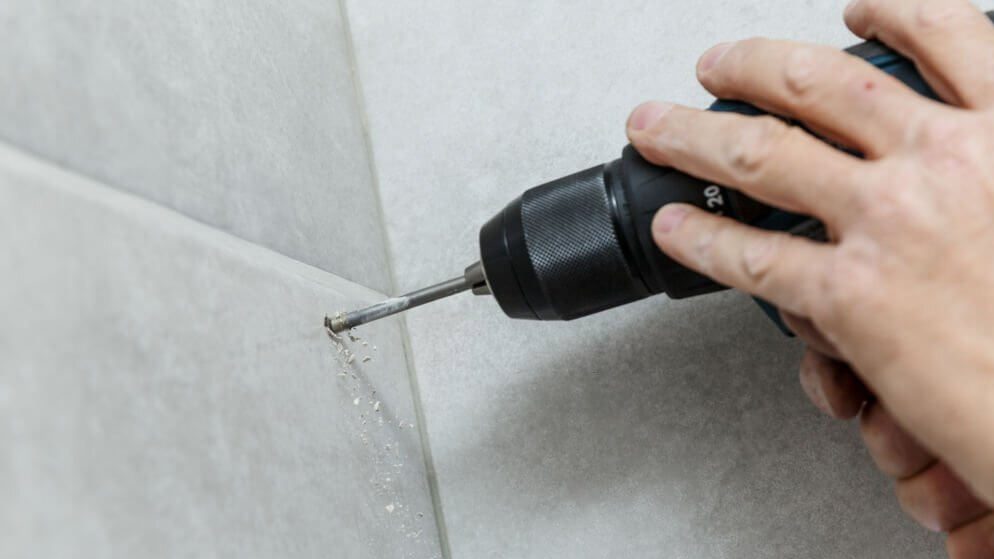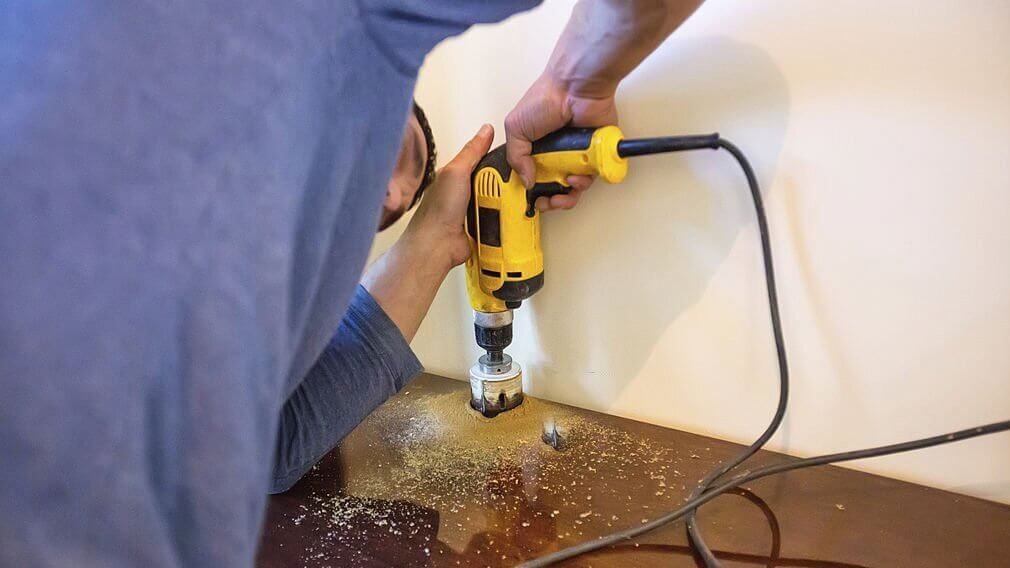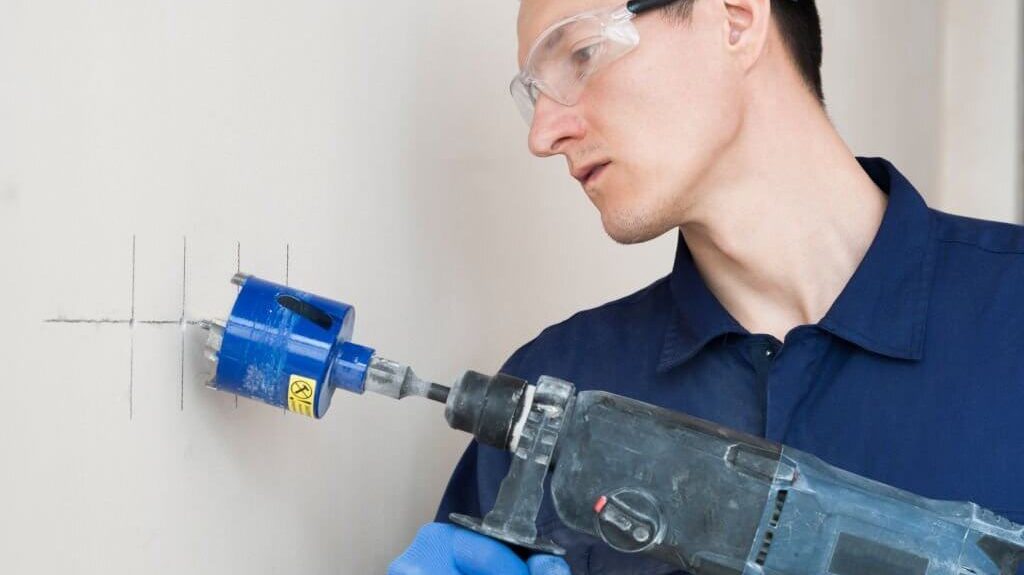Are you interested in learning how to drill into porcelain tile using a drill press? One of the most widely used materials for flooring and wall tiling applications is porcelain, so if you drill a lot, knowing how to best handle this tough surface is helpful.
We’ll give you all the information you need about setting up your drill correctly and taking safety precautions when working with porcelain tile. Get ready because we’re going to show you just how easy it can be!
Drilling into porcelain tile can be difficult and intimidating, even for the most experienced of drill press users. But with the right instructions and tools, you too can have success in drilling clean and straight holes through porcelain tile without damaging it or wasting time
Read on to learn more about what you need to know when getting started with this project so you don’t end up making costly mistakes!
How to Drill Through Tile in 7 Easy Steps
How to drill tile is very important to completing a good tile installation project. It can be elegant, tile cut beautifully, and everything lay evenly. But the job isn’t completed. This is the part that can damage your effort: drilling holes in tiles for the accents. One mistake or awkward move results in smashed, dirty tiles.
1. Clean Up the Tiles
It is your mark. Before attaching a towel or toilet paper, wash the tiles thoroughly. It’s an arduous task drilling tiles! Retain masking tapes Use a damp cloth to clean up dirt and dust from a drill. Install securing pins to the wall, and then attach bathroom accessories.
2. Prepare the Drill Bit
Clean the diamond tipped drill bits and lubricate them with light machine oil. This will improve the performance of your drill and help prevent an uneven hole in the tile. Check that there is no debris left on the drill bit before continuing.

3. Drill Bit Shapes
Choose the correct drill bit to fit the shape of your tile. A round hole can be drilled with a round drill bit. An elongated hole or slot for screws or anchors requires an elongated diamond-tipped drill bit. You may also use a carbide-tipped masonry bit if you have access to one.
4. Measure and Mark the Hole Locations
If this isn’t your first time drilling a tile, you’ll probably know that this is quite difficult. Before you get started, you can make things simpler. Apply masking tape to the tile where holes are desired. Measure out the point and mark it with an X if necessary.
Masking tape creates tension when drilling, and it keeps the drill bits from falling. You may use leveling tape to check that the masking is installed correctly. Nobody wants crooked tiles!
5. Start Drilling
Position your drill at an angle determined by the shape of your tile and the marking you have made. Start drilling slowly in a circular motion and increase speed when necessary. Always keep the drill bit perpendicular to the surface for optimal results.
6. Release the Drilled Tile
You may notice that smoke is coming out from around the hole, or that tiles are being pushed away by the force of the drill. In these cases, stop drilling and slowly release the tile. If it’s stuck in place, use a pair of pliers to carefully remove it without damaging the surrounding tiles.
7. Rinse Off Debris
Once you have finished drilling your hole, rinse off any debris created by the process with water. Make sure that all pieces of tile are removed from the hole.
8. Clean Up
Finally, remove any masking tape used during the process and clean up your workspace. Congratulations! You have successfully drilled a hole in your tile. Now you can attach all of the necessary accents to complete your project.
Related: How Close to Edge of Concrete Can you Drill?
How to Drill Through Tile
Be careful not to cut into the bare surface and start digging in. This may seem incredibly easy to do, especially if one has little knowledge of tile materials and their properties. Even with a certification in CTI, small mistakes may cause damage to a tile’s surface. We also have a lot of tips on the right way to clean tile.
However, you should note that following this procedure will not ensure that the tiles won’t fall out. It is purely possible that it is very little.

What Makes Porcelain Tile So Hard to Drill?
In a ceramic kiln heat is used to make ceramic tiles harder to drill. The high temperature at the kiln modifies both its compositions and crystallography for the silicon-rich materials. The higher kiln temperature turns the putty-like ash into artificial stone.
In the initial phases of tile manufacturing, the clay used for the construction of the tile was putty. Some can be made by hand but the rest cannot be created using a machine because it is stiff. During heat, the crystal’s structure changes and it changes just as plastic can transform after it was put into the read-mix truck.
Why Does the Tile Glaze Make Drilling Into Tile Difficult?
Glass tiles are slippery and have shiny glazes. Tiles can slide onto tiles causing hard holding. Generally used ceramic tiles have been formed mostly from clay and are then glazed by a thick glaze of silica.

The silica is cured in a kiln in which the clay transforms into sand-like rocks. Once the drill bits penetrate the thick glass coating it normally penetrates into the inside core of regular ceramic tiles. The outer core of these tiles is quite softer.
How to Drill Ceramic Tile TIPS
Drilling ceramic tiles has now become an essential job. I am looking for new towels for my bathroom. This also means installing anchored shower doors. The hole is drilled into the tiles but nothing quickly happens. The bit was smoked with red cherries.
I have to finish that before the wife returns. Tell me the best thing you have in store for me. I’ve seen this article in the news. I’ve had it. I’ll have a lot to pay for. You can be my Superhero in your life.
I will give you some of the useful tips to help you drill ceramic tiles. There are many things to consider before drilling ceramic tiles and these include:
- Choose the right drill bit – It is essential to select a high-quality diamond-tipped drill bit which can easily penetrate through the tile’s surface without causing any damage.
- Use lubricants – Lubricants can help in reducing friction during drilling, thus making the job easier and faster.
- Drill slowly – It is best to start drilling at a slow speed and gradually increase it as you get deeper into the tile’s surface. This will reduce the chances of cracking or splitting the tile due to sudden pressure.
- Protect yourself and your surroundings – Before you start drilling, make sure to wear protective gear such as safety glasses, gloves, and dust masks. Also, be aware of the flying particles of ceramics as they can be harmful if inhaled or come in contact with skin.
- Get help – If you find the task of drilling ceramic tiles too difficult, it is best to take help from a professional who is well-versed in this job.
By following these tips and tricks correctly, you can easily drill ceramic tiles without any hassles. So what are you waiting for? Get started right away
Drill Into Porcelain Tile FAQs
What is the Best Tile Drill Bit Speed?
The slowest tile drill bit speeds are ideal to drill normal ceramic tiles. Apply a little pressure on the drill so the piece is smashed at the glazes and the tiles. You’re wasting time by heating drills.
Can I Use a Hammer Drill for Drilling Into Tile?
Oh! You must avoid drilling tile with hammers. This is commonly known as a percussion drill. Although it is mainly used to drill hard materials it is not used to drill tiles.
Hammer drill is effective at breaking all tiles on the floor. It can work with bricks and stones but it can’t work with tile.
How to Drill Through Porcelain Tile Without Cracking?
Never go too fast on tile, as it may become cracked by overheating the drilling tool. Recommendation: Dispose the drills at 100-200 rpm.
This speed allows for a smoother surface without the need for high vibration to crack the tiles in the surface and cause cracks. This prevents overheating. Alternatively, use an updated diamond drill bit.
Why does the Drill Bit Smoke and Get Hot?
Drilling at high speeds causes friction that will cause a drill to burn, and a drill to overheat. You can prevent this by being careful to run fast and keep your drill cooler. You may use a wet sponge to spritz the surface with water or rub in cutting oil.
How do you Prevent Scratching Tiles?
Use a little pressure to drill for the best possible protection from scratches on tiles in the area. Pushing too hard can make the drill bits slip and create large scratches around tiles.
Use duct tape to protect your drill surface from slippage. This protects it from scratches.
What is the Best Drill Bit for Porcelain Tile?
The most effective bit to drill a porcelain tile in the kitchen or bathroom is a diamond shaped bit which works well with dense materials.
Some drill bits have water coolers, while others have wax fillings so that the bit won’t overheat or damage the diamond.
Are Porcelain Tiles Easy to Drill?
Since porcelain tiles and natural stones are thick, these are difficult to work through hence require more robust drilling bits. A drill bit with diamond tips is available for use on floor tiles.
What Tile Drill Bit is Used?
The key to drilling ceramic tiles in your house is to install the new drill bits with a carbide tip. You can never drill ceramic tiles at very high speeds.
What Tile is the Hardest to Drill?
Porcelain is the toughest floor surface. In porcelain manufacturing processes porcelain is tougher than granite.
Its higher silica content is also more brittle than porcelain tiles, which are also more resistant. You cannot cut porcelain tiles using tiles.
Conclusion
The task of drilling through porcelain tile may seem daunting, but with the right knowledge and tools, it doesn’t have to be.
By affixing a specialized drill bit to your drill, along with heavy-duty safety goggles and other protective equipment, you can safely complete the job and avoid any unnecessary costly mistakes.
One last tip: Always use multiple light sources to ensure the most accurate hole placement on your tile. Don’t forget that you should choose an appropriate speed and pressure setting for best results.
Don’t worry if drilling into porcelain tile feels overwhelming at first – by following these simple steps you can easily master the task and become confident in your ceramic floor installation skills. As long as you take the time to do things correctly, there is no reason why you won’t be able to achieve success!




